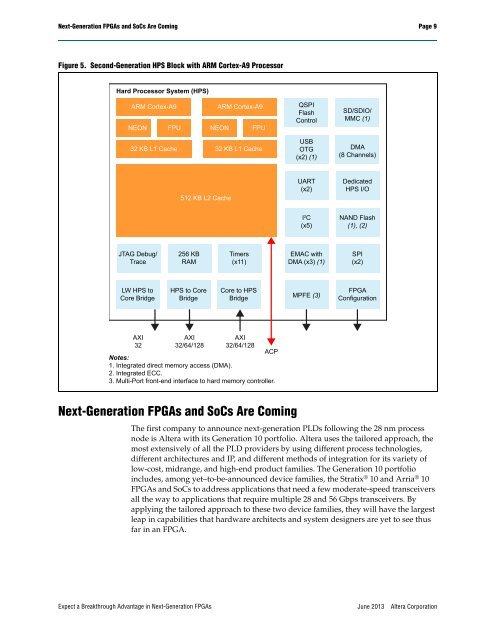Expect a Breakthrough Advantage in Next-Generation FPGAs - Altera
Expect a Breakthrough Advantage in Next-Generation FPGAs - Altera
Expect a Breakthrough Advantage in Next-Generation FPGAs - Altera
You also want an ePaper? Increase the reach of your titles
YUMPU automatically turns print PDFs into web optimized ePapers that Google loves.
<strong>Next</strong>-<strong>Generation</strong> <strong>FPGAs</strong> and SoCs Are Com<strong>in</strong>g Page 9<br />
Figure 5. Second-<strong>Generation</strong> HPS Block with ARM Cortex-A9 Processor<br />
Hard Processor System (HPS)<br />
ARM Cortex-A9<br />
ARM Cortex-A9<br />
NEON FPU NEON FPU<br />
32 KB L1 Cache 32 KB L1 Cache<br />
QSPI<br />
Flash<br />
Control<br />
USB<br />
OTG<br />
(x2) (1)<br />
SD/SDIO/<br />
MMC (1)<br />
DMA<br />
(8 Channels)<br />
512 KB L2 Cache<br />
UART<br />
(x2)<br />
Dedicated<br />
HPS I/O<br />
I 2 C<br />
(x5)<br />
NAND Flash<br />
(1), (2)<br />
JTAG Debug/<br />
Trace<br />
256 KB<br />
RAM<br />
Timers<br />
(x11)<br />
EMAC with<br />
DMA (x3) (1)<br />
SPI<br />
(x2)<br />
LW HPS to<br />
Core Bridge<br />
HPS to Core<br />
Bridge<br />
Core to HPS<br />
Bridge<br />
MPFE (3)<br />
FPGA<br />
Configuration<br />
AXI<br />
32<br />
AXI<br />
32/64/128<br />
AXI<br />
32/64/128<br />
ACP<br />
Notes:<br />
1. Integrated direct memory access (DMA).<br />
2. Integrated ECC.<br />
3. Multi-Port front-end <strong>in</strong>terface to hard memory controller.<br />
<strong>Next</strong>-<strong>Generation</strong> <strong>FPGAs</strong> and SoCs Are Com<strong>in</strong>g<br />
The first company to announce next-generation PLDs follow<strong>in</strong>g the 28 nm process<br />
node is <strong>Altera</strong> with its <strong>Generation</strong> 10 portfolio. <strong>Altera</strong> uses the tailored approach, the<br />
most extensively of all the PLD providers by us<strong>in</strong>g different process technologies,<br />
different architectures and IP, and different methods of <strong>in</strong>tegration for its variety of<br />
low-cost, midrange, and high-end product families. The <strong>Generation</strong> 10 portfolio<br />
<strong>in</strong>cludes, among yet–to-be-announced device families, the Stratix ® 10 and Arria ® 10<br />
<strong>FPGAs</strong> and SoCs to address applications that need a few moderate-speed transceivers<br />
all the way to applications that require multiple 28 and 56 Gbps transceivers. By<br />
apply<strong>in</strong>g the tailored approach to these two device families, they will have the largest<br />
leap <strong>in</strong> capabilities that hardware architects and system designers are yet to see thus<br />
far <strong>in</strong> an FPGA.<br />
<strong>Expect</strong> a <strong>Breakthrough</strong> <strong>Advantage</strong> <strong>in</strong> <strong>Next</strong>-<strong>Generation</strong> <strong>FPGAs</strong><br />
June 2013<br />
<strong>Altera</strong> Corporation
















